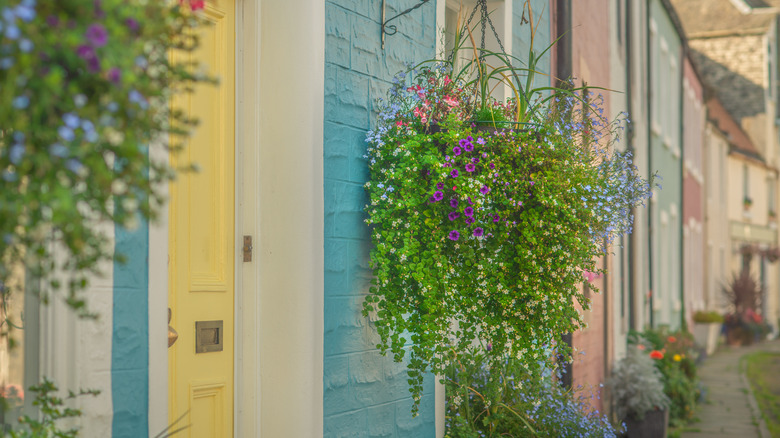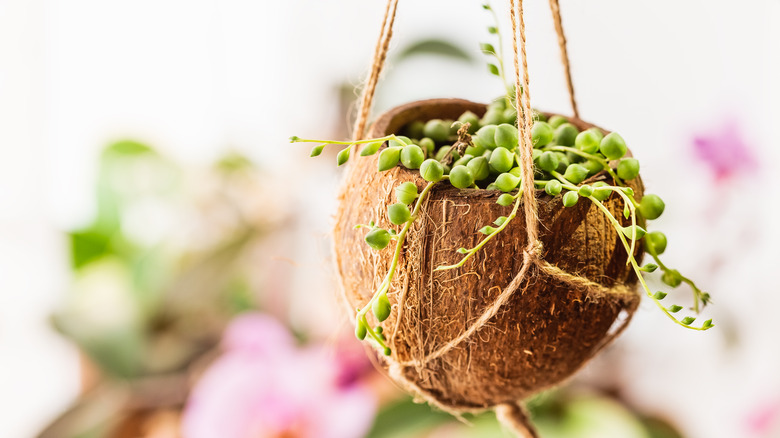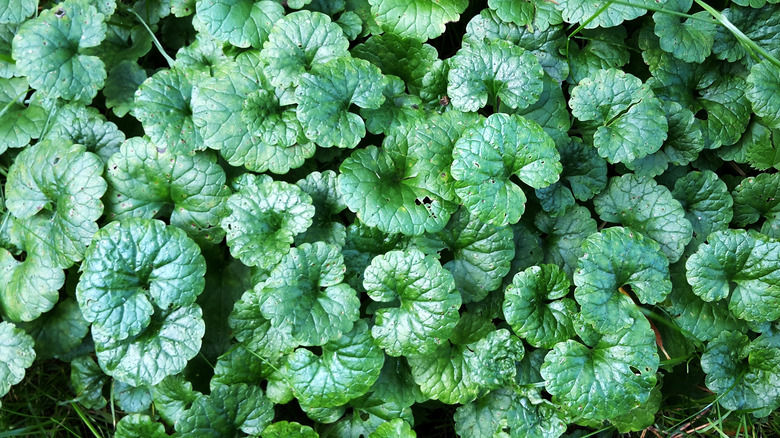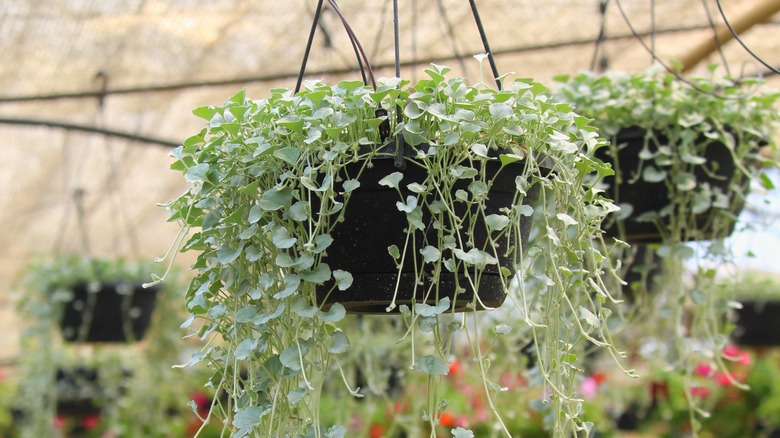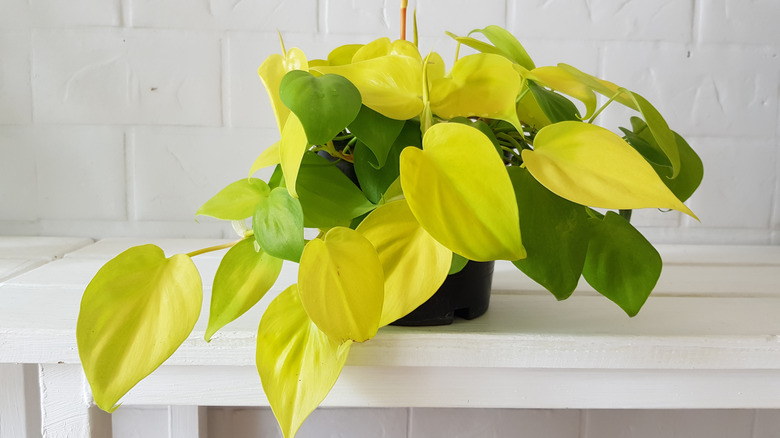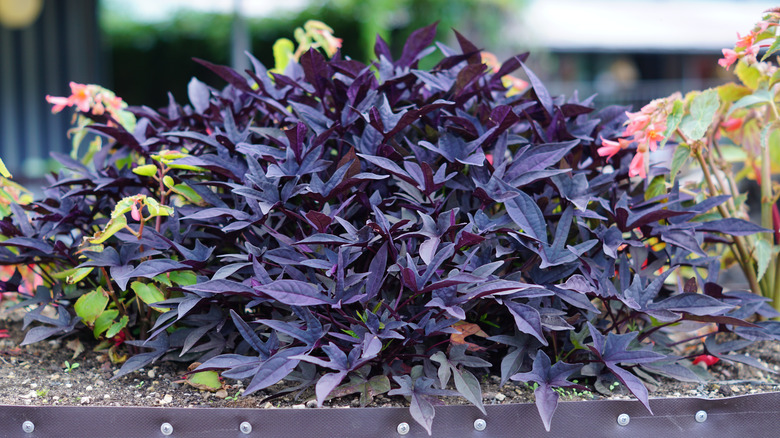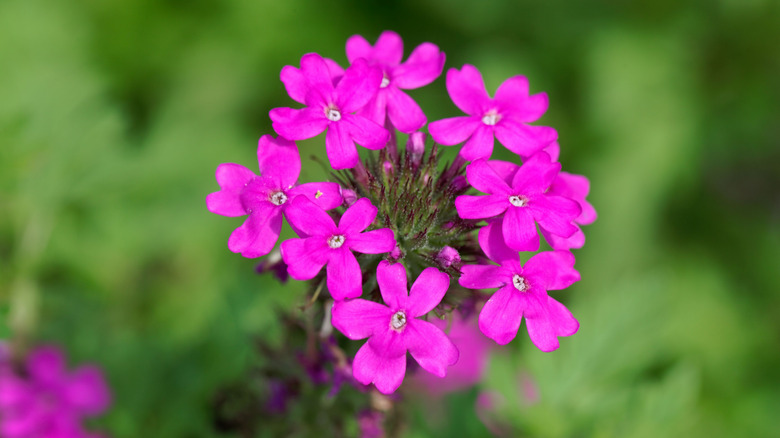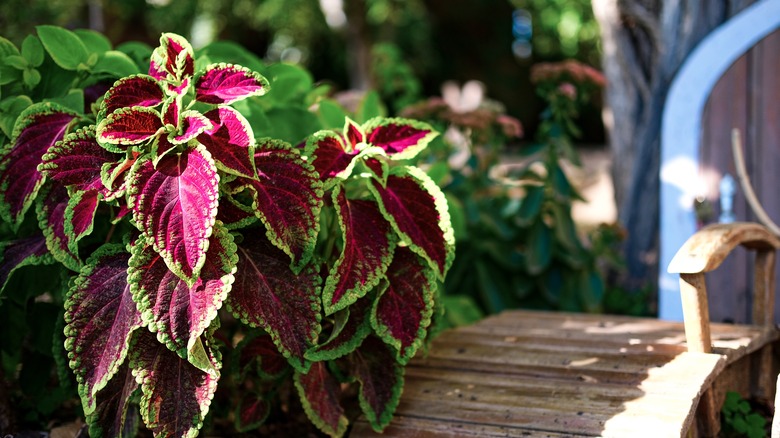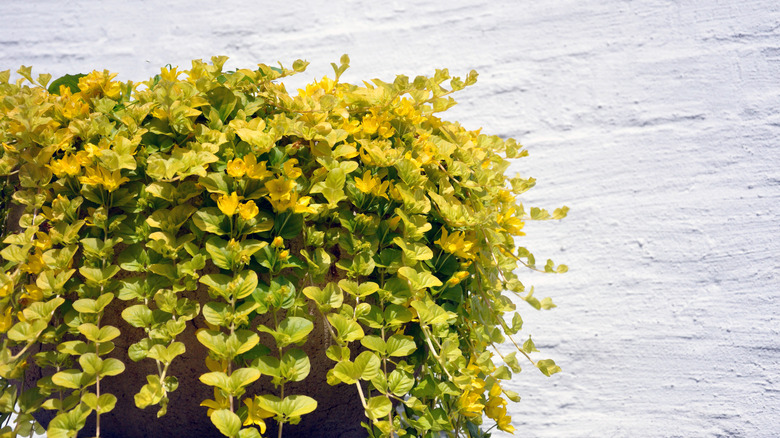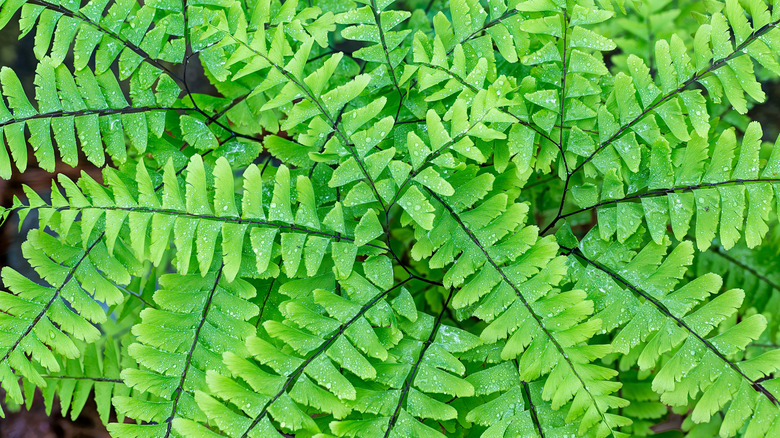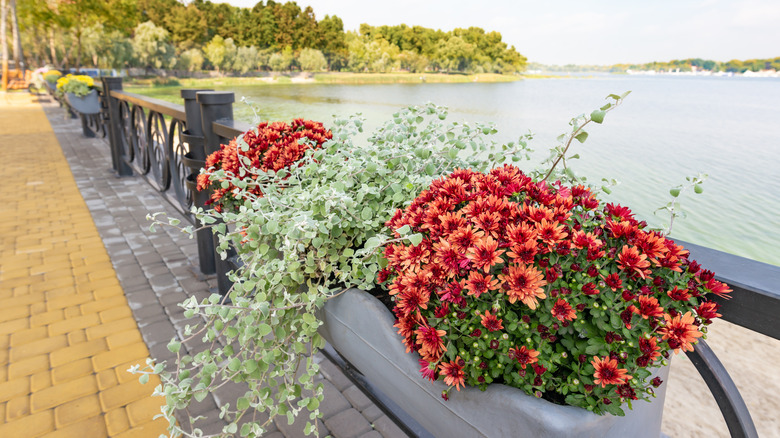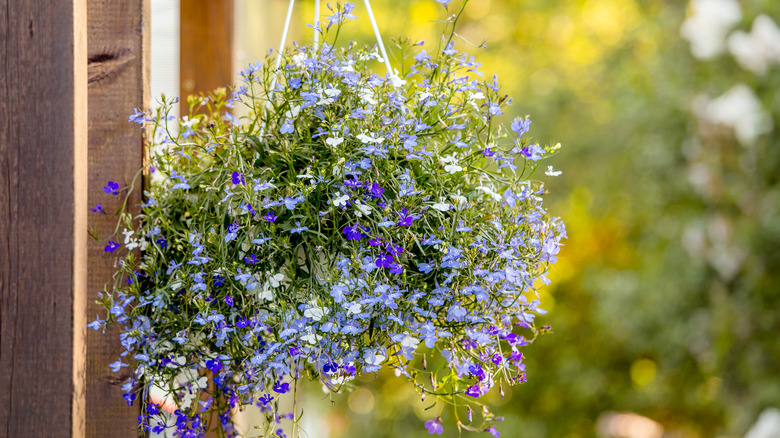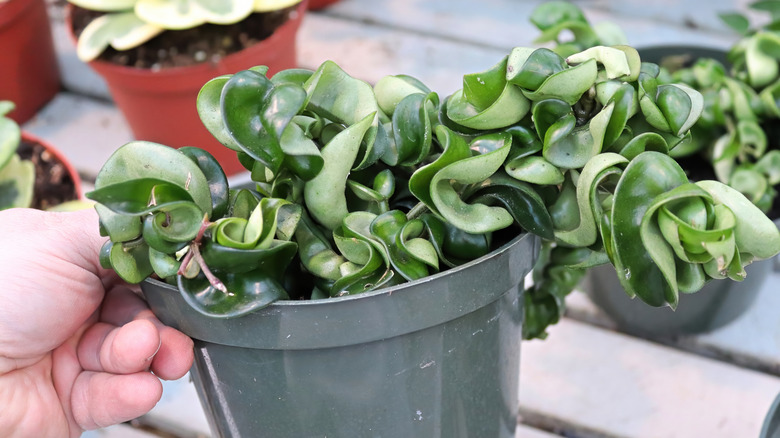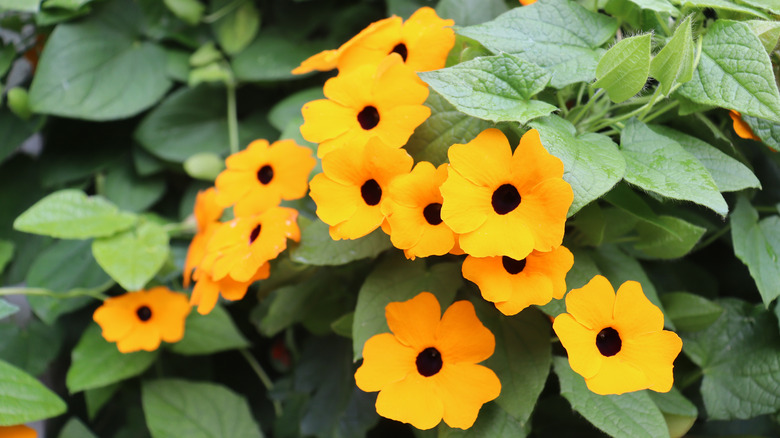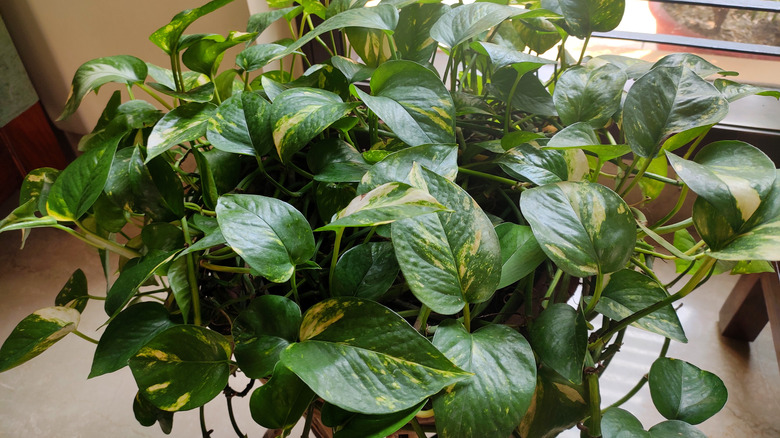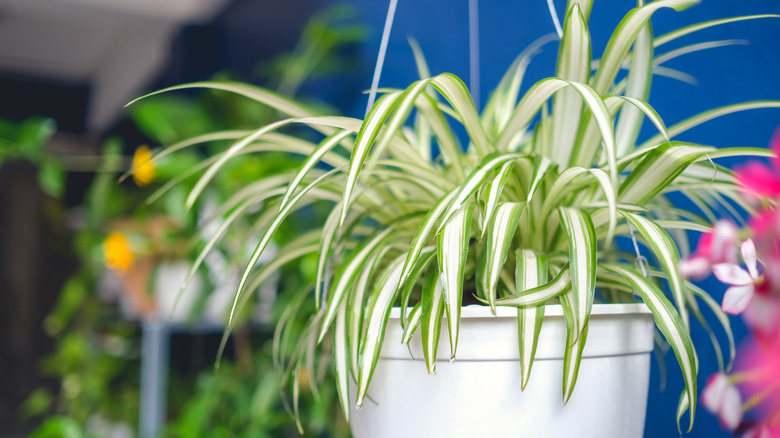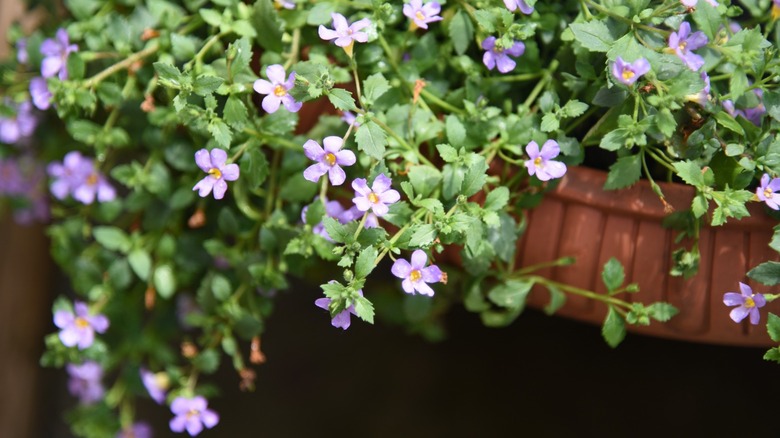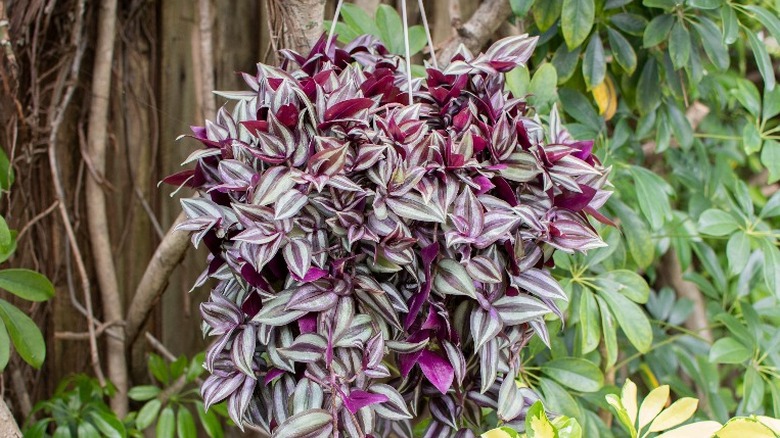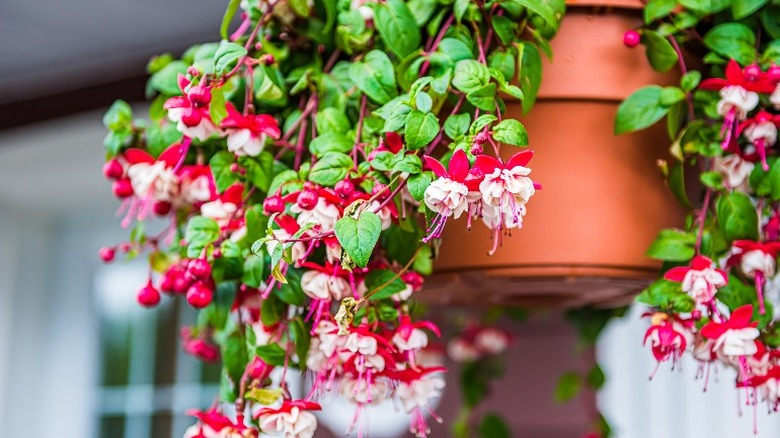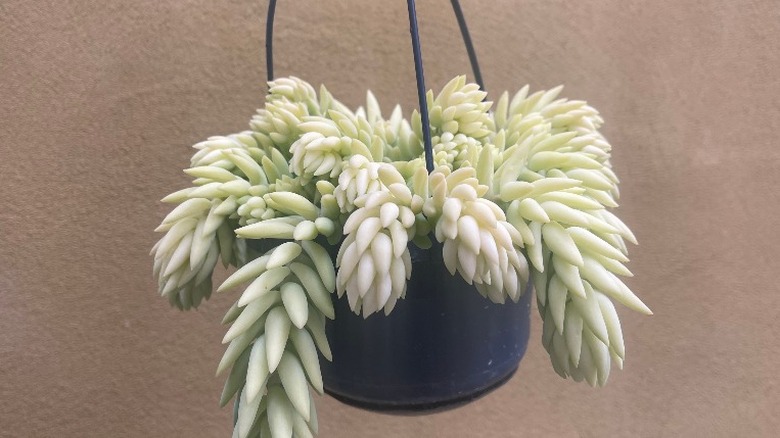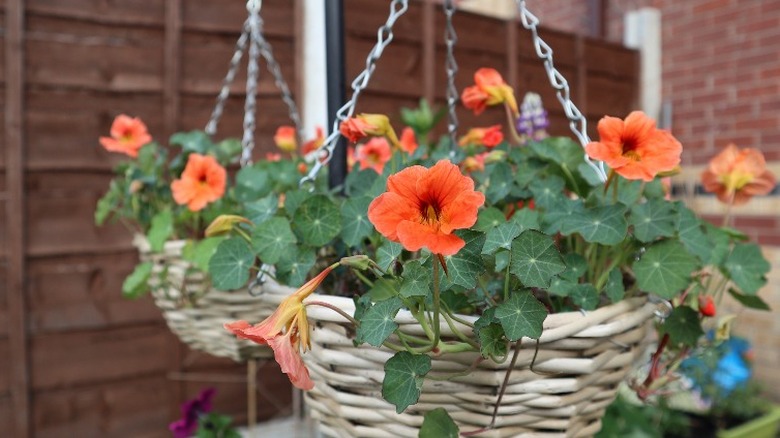20 Trailing Plants Perfect For Hanging Baskets
When you think of hanging baskets, what style comes to mind? There are several ways to design a hanging basket. From a bright, tightly packed combination blooming basket to one simple trailing flower type that delicately hangs off the edge of the container, there isn't a wrong answer. However, you should take more textures into consideration when filling your planter. Large, leafy options such as ferns and ivy can add a whole new visual aspect to your flower-filled porch.
As mentioned by Garden Therapy, hanging baskets make home gardening easier. When using this potting method, it's unlikely that you will have to deal with issues such as poor soil, weeds, and pests. However, you cannot care for a hanging planter the same way that you care for other plants, potted or otherwise. Keep in mind that many hanging plants need to be watered more often, fertilized every two weeks, and pruned frequently.
1. String of pearls
A string of pearls plant (senecio rowleyanus) can be identified from its spherical leaves that look like a string of beads that trail away from the plant's roots. As explained by the University of Wisconsin-Madison, this succulent is most often grown in hanging baskets where its stems can hang off of its container. Be sure to keep yours out of full sun and protect it from heavy rain.
Bloom Season: Summer
USDA Growing Zone: 9 to 11
Growing Conditions: Partial shade
Soil Type: Well-draining
Size: 1 to 3 feet long
2. Creeping charlie
Creeping charlies (glechoma hederacea) are also sometimes referred to as "ground ivy," "Cat's foot," or "Gill-over-the-hill," as said by North Carolina State Extension. This plant is known to be weedy in the wilderness, but it makes a wonderful hanging plant in a container. The creeping charlie has a long, rich history as it used to be used to make beer and medicine.
Bloom Season: Spring and summer
USDA Growing Zone: 3 to 10
Growing Conditions: Full sun to full shade
Soil Type: Well-drained clay, loam, or sand
Size: Less than 1 foot long
3. Silver falls dichondra
Silver falls dichondra (dichondra argentea) is grown as an annual in most climates, but when you plant it in a hanging basket, you can move it indoors for the winter. According to Missouri Botanical Garden, this herbaceous plant is very fast growing. In just one season, its stems can grow up to 6 feet long when they are trailing downward.
Bloom Season: Spring to Summer
USDA Growing Zone: 10 to 12
Growing Conditions: Full sun
Soil Type: Well-drained
Size: 3 inches tall and 4 feet wide
4. Trailing philodendron
Philodendron (philodendron hederaceum), also known as heart-leaf philodendron, is a climbing vine that enjoys low light conditions and moist soil, as per North Carolina State Extension. Trailing philodendron does produce small white flowers, however, they are rarely seen when this plant is grown inside the home.
Bloom Season: Spring and summer
USDA Growing Zone: 10 to 11
Growing Conditions: Partial shade to full shade
Soil Type: Moist and well-draining
Size: 4 inches to 6 feet long
5. Sweet potato vine
The sweet potato vine (ipomea batatas) is grown for its spectacular heart-shaped foliage that can be bright green, dark purple, or muted green depending on the cultivar. As told by Proven Winners, the trailing sweet potato vine does well in containers and hanging baskets where they receive plenty of sunlight.
Bloom Season: Spring and summer
USDA Growing Zone: 11
Growing Conditions: Full sun to part shade
Soil Type: Well-drained
Size: 4 to 10 inches tall and 4 to 5 feet wide
6. Verbena
Trailing verbena (glandularia canadensis), also called rose vervain, is a sprawling plant that produces wonderfully fragrant blossoms in the spring and summer. These flowers can appear purple or pink, and they form in small clusters, as shown by Gardenia. They are best used in hanging baskets on your porch, where guests can enjoy their sweet scent before entering your home.
Bloom Season: Spring to summer
USDA Growing Zone: 5 to 9
Growing Conditions: Full sun to part shade
Soil Type: Well-drained loam, clay, or sand
Size: 6 inches to 2 feet tall and 1 to 2 feet wide
7. Trailing coleus
Coleus (plectranthus scutellarioides) is often grown in pots, but not all of its species and varieties are well-suited for hanging. Trailing coleus spreads widely in hanging containers, so it spills over the edge for a beautiful burst of colorful foliage. As described by Missouri Botanical Garden, coleus foliage has been hybridized so many times that you can find it in several colors including blue.
Bloom Season: Summer to early fall
USDA Growing Zone: 10 to 11
Growing Conditions: Part shade to full shade
Soil Type: Loose, moist, and rich
Size: 6 inches to 3 feet tall and wide
8. Golden creeping jenny
Golden creeping jenny plants (lysimachia nummularia) are characterized by bright yellow leaves and thin stems. The ornamental plant is also sometimes called moneywort and herb twopence, as explained by the University of Wisconsin-Madison. In the summer, it displays yellow flowers that are difficult to distinguish from the leaves. Keep in mind this container plant doesn't bloom consistently; some years, you will not notice any blossoms.
Bloom Season: Summer to fall
USDA Growing Zone: 3 to 9
Growing Conditions: Full sun to full shade depending on the cultivar
Soil Type: Damp soil
Size: 2 to 4 inches tall
9. Maidenhair fern
The maidenhair fern (adiantum pedatum) is a popular hanging planter option because of its broad fronds and graceful shape, as per Prairie Nursery. The texture of this plant's leaves looks great next to several different kinds of flowers, so your front porch will look natural and bright.
Bloom Season: Summer
USDA Growing Zone: 3 to 8
Growing Conditions: Full to partial shade
Soil Type: Loam, sand, or clay
Size: 1 to 2 feet tall
10. Licorice plant
Licorice plants (helichrysum petiolare) are named after the fragrance that their soft leaves emit, says Gardenia. This evergreen shrub is commonly grown in hot and dry environments where the plant won't be subjected to freezing temperatures or too much rainfall. Though its blooms are insignificant, most gardeners allow them to blossom because they add more interest to the velvety leaves of the plant.
Bloom Season: Summer
USDA Growing Zone: 9 to 11
Growing Conditions: Full sun
Soil Type: Well-drained loam, clay, or sand
Size: 1 to 2 feet tall and 3 to 4 feet wide
11. Lobelia
Lobelia (lobelia erinus) blooms profusely with blue and violet flowers that are just ½ inch wide, as described by Missouri Botanical Garden. Lobelia plants work great in combination plantings that bring out their beautiful color. Remember that these flowers look their best in the spring and summer when they are in full bloom; you may decide to relocate your plant during its dormant season.
Bloom Season: Spring and summer
USDA Growing Zone: 10 to 11
Growing Conditions: Full sun to part shade
Soil Type: Well-drained and organically rich
Size: 6 to 9 inches tall and wide
12. Rope hoya
Rope hoya (hoya carnosa 'compacta') is most often used as a houseplant, but it can look great in outdoor hanging baskets too. As mentioned by North Carolina State Extension, your plant won't need frequent waterings, however, it does need high humidity, so it won't do well in climates that experience dry summers.
Bloom Season: Spring and summer
USDA Growing Zone: 10 to 12
Growing Conditions: Partial shade
Soil Type: Well-draining with high organic matter
Size: 15 inches long
13. Black-eyed susan vine
Black-eyed susan vines (thunbergia alata) are named after their resemblance to true black-eyed Susan flowers. They are well-known for their ability to quickly climb trellises, fences, and walls, via Gardenia. When planted in a hanging basket, this plant will quickly climb down to the ground or to the nearest structure it can hold onto.
Bloom Season: Summer to early fall
USDA Growing Zone: 10 to 11
Growing Conditions: Full sun to partial shade
Soil Type: Well-drained chalk, loam, or sand
Size: 3 to 8 feet tall
14. Devil's ivy
Devil's ivy (epipremnum aureum) is one of the best plants for beginner gardeners looking to bring some green into their lives, according to The Sill. It can tolerate just about any kind of soil, humidity, and watering schedule as long as you don't give it too much love. When used in a hanging basket, this pothos plant will thrive indoors and outdoors in the right temperatures.
Bloom Season: Does not flower
USDA Growing Zone: 10 to 12
Growing Conditions: Full shade to partial shade
Soil Type: Well-drained
Size: 6 to 10 feet long
15. Spider plant
The spider plant (chlorophytum comosum) is a neglect-tolerant, drought-tolerant, and shade-tolerant herbaceous plant. Its slender, trailing leaves, which are likened to spider legs, produce small white flowers when the plant is cared for properly, as noted by the University of Wisconsin-Madison. Try growing yours outside in your area's warmer seasons to see its unique foliage thrive.
Bloom Season: Spring and summer
USDA Growing Zone: 9 to 11
Growing Conditions: Full sun to partial shade
Soil Type: Well-drained
Size: 12 to 15 inches tall
16. Bacopa
Here is a trailing plant that's right at home in hanging baskets, and what it lacks in height is more than made up for in length. Bacopa is a creeping perennial that produces five-petaled white, blue, or light purple flowers. These plants are also known as water hyssop because they are semiaquatic and can be used in aquariums as well as hanging baskets.
Bloom Season: Spring to summer
USDA Growing Zone: 8 to 11
Growing Conditions: Full sun
Soil Type: Moist, plentiful
Size: 4 to 8 inches tall and up to 4 feet long
17. Tradescantia Zebrina (inch plant)
The appealingly-named and aesthetically pleasing Tradescantia zebrina only has tiny white flowers but that doesn't matter because its show-stopping, striped purple, green, and silverish-white leaves get all the attention. Be careful with this perennial hanging plant though, because the sap inside the stems can irritate the skin.
Bloom Season: Spring to Summer
USDA Growing Zone: 8 to 12
Growing Conditions: Full sun to partial shade
Soil Type: Moist, well-drained
Size: 6 to 9 inches tall and 1 to 2 feet long
18. Fuchsia
The fuchsia plant's most distinguishing feature is its upside-down flowers that come in bright purple and pink, or sometimes white and red, while its leaves are medium-green and oval-shaped. Make sure to look for the weeping varieties as they do best in hanging containers. And as a bonus, fuchsia flower nectar attracts hummingbirds.
USDA Growing Zone: 10 to 11
Growing Conditions: Partial shade to full sun
Soil Type: Moisture retentive
Size: 1 to 2 feet high and 1 to 2 feet long
19. Burro's tail
Better known for its extraordinary foliage than its flowers, the tropical, perennial Burro's tail is a unique, trailing succulent. The leaves fill up with water and the weight brings them down, so be sure to have sturdy hanging baskets for these heavy plants. They will produce small, bright red and pink flowers in the right conditions, but they need attentive care to bloom.
USDA Growing Zone: 9 to 11
Growing Conditions: Bright light to part sun
Soil Type: Well-draining, sandy, mixed soil
Size: 12 inches tall and up to 4 feet long
20. Climbing Nasturtium
The climbing nasturtium's trailing vines drape beautifully and sport orange, salmon-colored, and red flowers. And interestingly enough, the flowers, leaves, and seedpods are edible. These annuals come in a climbing and trailing type so choose these instead of the bush type for hanging baskets. They are somewhat drought-tolerant but need to be watered regularly and trimmed back during the growing season.
USDA Growing Zone: 2 to 11
Growing Conditions: Full sun
Soil Type: Slightly acidic, well-drained
Size: 1 to 3 inches tall and 5 to 6 feet long
